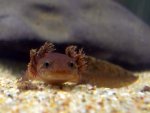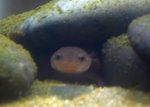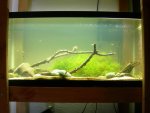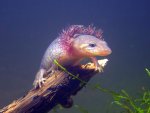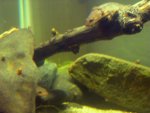pete
Active member
- Joined
- May 7, 2007
- Messages
- 550
- Reaction score
- 30
- Points
- 28
- Location
- CA
- Country
- United States
- Display Name
- Pete
Hello, I'd been pondering what to put in a vacant aquarium for awhile. Since CA banned all Ambystoma, I've been cut off from my usual caudate fix. I had been considering D. ensatus since it's legal (although quite difficult to find a legal place to collect.) Unfortunately, there is little knowledge available for captive Dicamptodons apart from this website, so I was hesitant to collect any initially. However, there has been some activity lately in this topic with a few individuals obtaining these salamanders, so I decided to go ahead and jump on the bandwagon. I finally found both a site and salamanders, and this weekend I caught myself, two larvae (13 cm and 15 cm). The site was a slow-moving stream in a Douglas fir/Redwood forest in the coastal ranges (A textbook location for Dicamptodon if I've ever seen one.) Below is a quick and sloppy photo I took of the larger one. I'll pester them more for photos once they settle in better. At this point I'm most concerned about ensuring that they begin to eat regularly and relax in their new home. Currently, they seem to prefer to hide in my mass of java moss more than the rocks that I've provided, and I'm fine to let them where they're comfortable at this point.
My first question is diet-related. So what are you guys feeding your larvae? I've tried worms, guppies, ghost shrimp, and there is bountiful snails to eat if interested in the tank. I have one that has already eaten a worm (a surprisingly large worm considering it's small size.) The other one seems a bit afraid of worms at this point, but is constantly trying for the guppies. They don't show any interest in the ghost shrimp. I didn't find much in the creek where I found them aside from water skippers and a few signal crayfish (which I suspect could have eaten the Dicamptodons had they the opportunity.)
My second question is related to metamorphosis. The information that I've been able to put together so far is that on average D. ensatus tend to morph in their second year when they're about 14 cm between the months of June and September. Although some wait around for another year and there is no hard rule for morphing with these guys. So I figure that I'm either due to morph soon, or I may end up with paedomorphic salamanders (which is fine with me, and I think I'd actually prefer aquatic ones.) With tigers I found it quite clear when they are going to transition to terrestrial phase (gill loss/changes in head morphology, pattern development, limb changes, air gulps). I feel that the Dicamptodon larvae, have quite small gills and quite well-developed limbs, and a bit of some pattern, but show little interest in the surface. So, is there any obvious sign or signs of impending metamorphosis that anyone has noticed or should I just keep an eye on their behaviors and tiny gills?
[Finally, if you are reading this and want a Dicamptodon, please don't PM me and ask for locations, that's part of the joy collecting. I won't ruin it for you. Larvae aren't hard to find either, if you can't find them, then I think you haven't really looked.]
My first question is diet-related. So what are you guys feeding your larvae? I've tried worms, guppies, ghost shrimp, and there is bountiful snails to eat if interested in the tank. I have one that has already eaten a worm (a surprisingly large worm considering it's small size.) The other one seems a bit afraid of worms at this point, but is constantly trying for the guppies. They don't show any interest in the ghost shrimp. I didn't find much in the creek where I found them aside from water skippers and a few signal crayfish (which I suspect could have eaten the Dicamptodons had they the opportunity.)
My second question is related to metamorphosis. The information that I've been able to put together so far is that on average D. ensatus tend to morph in their second year when they're about 14 cm between the months of June and September. Although some wait around for another year and there is no hard rule for morphing with these guys. So I figure that I'm either due to morph soon, or I may end up with paedomorphic salamanders (which is fine with me, and I think I'd actually prefer aquatic ones.) With tigers I found it quite clear when they are going to transition to terrestrial phase (gill loss/changes in head morphology, pattern development, limb changes, air gulps). I feel that the Dicamptodon larvae, have quite small gills and quite well-developed limbs, and a bit of some pattern, but show little interest in the surface. So, is there any obvious sign or signs of impending metamorphosis that anyone has noticed or should I just keep an eye on their behaviors and tiny gills?
[Finally, if you are reading this and want a Dicamptodon, please don't PM me and ask for locations, that's part of the joy collecting. I won't ruin it for you. Larvae aren't hard to find either, if you can't find them, then I think you haven't really looked.]

